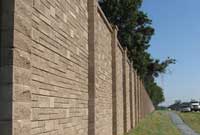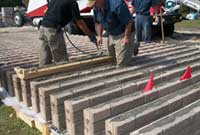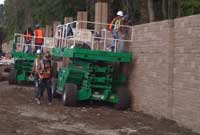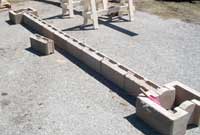
Print Case Study
Project Information
Name: US 17
Mount Pleasant, South Carolina
Product: AB Fence with Ashlar Blend Pattern
Size: 3000 ft (915 m) long 12 ft (3.7 m) tall
Local Engineer: George A. Z. Johnson, Jr., Inc.
General Contractor & Wall Builder: Gulf Stream Construction
Allan Block Manufacturer:
Block USA - Atlanta, Georgia





US 17 Mount Pleasant Sound Barrier Fence Project
As with any community that once considered themselves to be small, the community of Mount Pleasant, South Carolina has seen major population growth over the years. With this growth the traffic congestion and noise have continued to increase to a point that DOT traffic studies gave the US 17 corridor a ‘D’ Grade. This poor grade was only projected to get worse, forcing the DOT and the city to develop a plan to expand and upgrade the corridor. This upgrade was not only to relieve traffic congestion but also to reduce the increasing noise problems to the surrounding residential neighborhood. The city of Mount Pleasant, to date, had no sound walls and wanted to set a standard with their first. The City chose the AB Fence System with the Ashlar Blend Pattern for its aesthetic quality, its performance in reducing noise and its competitive cost.
Plan
The South Carolina Department of Transportation performed many noise studies in the corridor to determine the optimum wall location and dimensions. The city and state engineers worked closely together during the planning process to develop a solid plan to move forward with public hearings and product selections. Sound walls were new to the area and the plan initially met some resistance. However, the hearings proved that if the community was going to build their first sound walls, they wanted a quality wall system that would look great long into the future.
Design
The design of this project was dictated by the South Carolina DOT, therefore it was required to follow the AASHTO Guide Specifications for Structural Design of Sound Barriers. The Allan Block engineering department assisted the designing engineer, Steven Johnson of George A. Z. Johnson, Jr., Inc., to work through the preliminary and final designs. The design parameters set by AASHTO were 90 mph wind loads multiplied by a customary 30 % increase for wind gusts. A reinforced drilled shaft footing below each AB Fence post was designed by Johnson. Additionally, the SC DOT required a reinforced concrete leveling pad below each panel. The design of the posts and panels followed Allan Block’s Fence Engineering Manual, which calls for structurally reinforced columns and dry-stacked block panels with predetermined courses reinforced and cast solid as bond beams. The system works as a traditional post and panel system with the panels transferring loads laterally to the posts and the posts transferring loads to the footing. Due to the larger coastal wind loads and AASHTO requirements, the project utilized the Allan Block Large Post Block, which greatly increases the post capacity.
Build
Because this was the first AB Fence project for general contractors, Gulf Stream Construction, they invited an Allan Block Project Specialist to the site to train their installers. The specialist showed them how easy the AB Fence installs if they start off correctly. The installation crew caught on quickly and were off to the races. They followed the AB Fence Installation Guide closely and brought in a few of their own tricks along the way while maintaining the high quality of the system. The most important thing to know prior to construction is the exact post spacing. Allan Block recommends that this dimension be determined by measuring the actual product on site. Because the AB Fence System is modular, there can be slight variations in the delivered product. Gulf Stream brought in product and set up mock posts and panels prior to digging the drilled shafts to insure the correct post spacing.
Due to the tight schedule, Gulf Stream decided to mass-produce the bond beams by precasting them off-site and trucking them to the site. The bond beams could then be easily lifted off the trucks and lowered into position within each panel. They also worked with a local ready mix company to develop a fine mix for the bond beams that wouldmeet the strength requirements, be self-consolidating, and not require the extra vibration step. These steps proved to be real time savers.
Because the project called for the Ashlar Blend Pattern with random blocks flipped back and forth for added facial texture, extra time was required to achieve the high aesthetic quality of each panel. To reduce installation time and maintain a consistent pattern, Gulf Stream decided to have the same crew that build all the precast bond beams, also come to the site to place the dry-stacked pattern block that go between each bond beam. Gulf Stream was also able to hire additional workers as needed to aid in less technical projects around the site. Another time saver was the prefabrication of all the column steel. Instead of placing and tying individual bars and stirrups together, they could lift in place the entire rebar cage and start placing post block.
The speed at which the AB Fence System can be installed was one of the many factors that made this project such a success. The City of Mount Pleasant was so happy with the overall project that the AB Fence System has been chosen for their 2011 US 17 expansion project which includes 4 separate walls totaling over 55,000 ft² (5100 m²).

